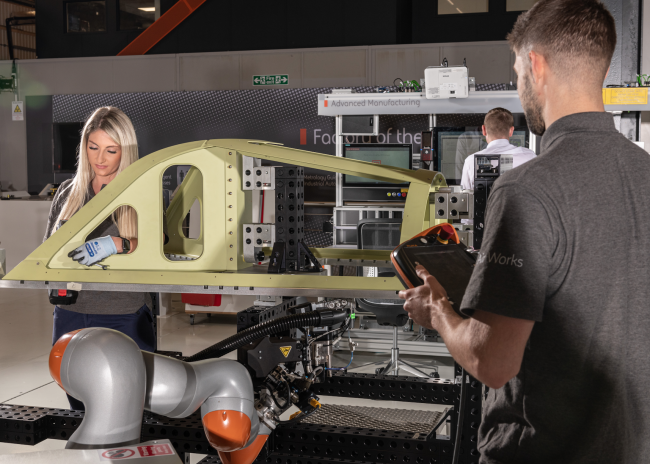4 minute read
Tempest future combat air programme poised to drive productivity, innovation and skills development
An independent report produced by professional services firm PwC, has shown that the economic impact of the Tempest programme will be felt in every region of the UK, supporting an average of 21,000 jobs a year, with 70% of the programme’s value generated in the North West, South West and East of England.
The Tempest programme is expected to generate long-term high value employment, with productivity per worker 78% higher than the national average, underlining how this programme can make a significant contribution to the UK government’s levelling up priorities and the wider economy.
The programme is being delivered by Team Tempest – combining the expertise of the UK Ministry of Defence (MOD), BAE Systems, Leonardo UK, MBDA UK and Rolls-Royce. Working with international partners, the team is leading progress towards a UK-led internationally collaborative future combat air system which will ensure the Royal Air Force and its allies retain world-leading, independent military capability.
Key to the success of Tempest is delivering this highly-advanced capability more rapidly and more cost effectively than ever before.

The Tempest programme is estimated to make a £26.2bn contribution to the UK economy and support 21,000 jobs each year from 2026 to 2050 / Picture: BAE Systems
Never miss the latest manufacturing news by signing up to our newsletter here
Investment by industry and the MOD in research and development for Tempest will generate positive spill-over benefits for the wider economy and drive innovation in collaboration with hundreds of companies, SMEs and academic organisations.
The PwC report confirmed the expected impact of the Tempest programme will make an estimated £26.2bn contribution to the UK economy between 2021 and 2050, and create high productivity employment with an average GVA per worker of £101,000, 78% higher than the UK national average and 42% higher than the country’s manufacturing average. From development to operational service (2026-2050) the programme will support on average 21,000 jobs per year and support significant benefits across regional economies.
Diane Shaw, EMEA aerospace, defence and security consulting leader at PwC, said: “As our research outlines, the scale of the Tempest programme is significant and expected to deliver wide-ranging benefits to the UK, stimulating investment in new technologies and promoting critical skills and capabilities that ensure the UK can continue to operate at the forefront of world-leading technology. The programme will stimulate R&D in regions most in need and generate wider economic benefits for these areas, supporting the UK government’s levelling up priorities and contributing to the UK’s economic recovery and prosperity in the decades ahead.”

The Tempest programme will create high productivity employment with an average GVA per worker of £101,000, 78% above the UK national average / Picture: BAE Systems
The Team Tempest partners are already engaged with more than 600 suppliers, SMEs and academic institutions across the UK, helping to deliver benefit beyond the defence sector.
ADS chief executive, Kevin Craven, said: “The Tempest programme will bring tens of thousands of skilled jobs that will provide rewarding careers, help to level up the UK economy, and build the advanced capabilities of our world-leading combat air industry. The contribution of SMEs will be vital to Tempest’s success and I hope our network of innovative supply chain companies will explore the opportunities to be involved in the programme and maximise the benefits to our sector and our national prosperity.”
Tempest programme regional impact
North West
The programme is expected to generate at least £7.9bn GVA.
Will support on average 5,000 highly skilled jobs per year directly employed on the programme and in the first tier of the supply chain.
Productivity 31% higher than the North West manufacturing average.
South West
The programme is expected to generate at least £2.7bn GVA.
Will support on average 2,000 highly skilled jobs per year directly employed on the programme and in the first tier of the supply chain.
Productivity 24% higher than the South West manufacturing average.
East of England
The programme is expected to generate at least £1bn GVA.
Will support on average 750 jobs highly skilled jobs per year directly employed on the programme and in the first tier of the supply chain.
Productivity 60% higher than the East of England manufacturing average.

Tempest is a next generation combat aircraft due to come into service in 2035, replacing the Eurofighter Typhoon / Picture: BAE Systems
The Tempest programme is already a magnet to attract engineers and technicians and a place for young people to build their long-term careers. There are currently more than 2,000 people employed across UK industry and the MOD on the programme.
Combat Air activities of the four Team Tempest partners are expected as a whole to contribute £100.1bn to the UK economy and support 62,000 jobs per year between 2021 and 2050. Tempest makes up an increasing share of the partners’ UK Combat Air activities and that of their supply chains, rising from around 12% today to nearly 50% of economic contribution by 2050 and is a crucial element of the aerospace and defence industry’s ongoing prosperity.